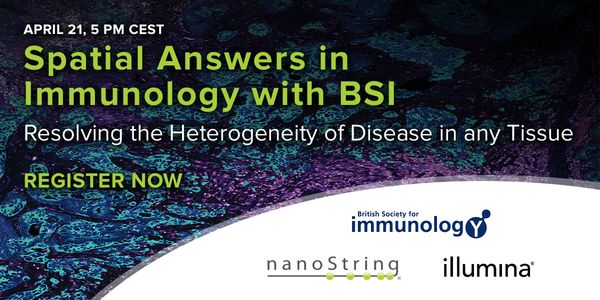Spatial Transcriptomics
Spatial transcriptomics utilizes a variety of methods to define cell types, by means of mRNA data, to their histological locations. Spotted arrays of specialized mRNA probes are often used capturing information about subcellular localization of mRNA molecules.
-
JUL 15, 2021 | 9:00 AMDate: July 15, 2021 Time: 9:00am (PDT), 12:00pm (EDT) The Pisces workflow robust, easy-to-use, end-to-end multi-omics solution for highly multiplexed targeted Spatial RNA analysis. VeranomeB...JUN 02, 2021 | 8:00 AMDate: June 2, 2021 Time: 8:00am (PDT), 11:00am (EDT) In this introduction Kelly Hunter will address the first Learning Objective. He will cover i) a range of digital pathology and tissue mul...Speaker: Kelly Hunter, BSc Biochemistry, MSc Genomics Medicine , Dr. Graham Taylor, BSc, Ph.DSponsored By: Leica BiosystemsAPR 22, 2021 | 5:00 PMDate: April 22, 2021 Time: 8:00am (PDT), 11:00am (EDT), 5:00pm (CEST) System transcriptomics of the schizophrenia brain - Phillip Khaitovich Schizophrenia tops the psychiatric disorder l...APR 21, 2021 | 5:00 PMDate: April 21, 2021 Time: 8:00am (PDT), 11:00am (EDT), 5:00pm (CEST) Spatial Answers Trilogy - Spatial Answers in Immunology Immunology Researchers share their Spatial Discoveries in SARS-C...Speaker: Doug Brown, PhD , Susanne Krasemann, MD, PhD , Michelle Naughton, PhDSponsored By: NanoString Technologies, IlluminaCOVID-19 is a severe disease that has caused >1 million deaths in under one year. As this disease is novel, the molecular and cellular underpinnings of the progressive tissue injury are p...Speaker: Christopher Mason, Ph.D
APR 20, 2021 | 5:00 PM
Date: April 20, 2021 Time: 8:00am (PDT), 11:00am (EDT), 5:00pm (CEST) Spatial Answers on Oncology - Professor Joan Seoane Prof. Joan Seoane, Group Leader and Director of the Translational Re...
Speaker:
Noel De Miranda
, Vasilis Stavrinides, MD
Sponsored By: NanoString Technologies,
Illumina
Traumatic brain injury (TBI) is best characterized as brain dysfunction caused by an outside force, usually a violent blow to the head, often occurring as a result of a severe sports injury...
Learning Obejctives: 1. Understand the key requirements for sample preparation in a single cell and/or spatial transcriptomics experiment 2. Learn the synergies between a combined single cel...
Biological systems are comprised of numerous cell types, intricately organized to form functional tissues and organs. Cell atlas initiatives with single-cell RNA sequencing have begun to cha...
Two studies on the immunology of COVID-19 are included in this webinar: First, Eugenia Ong, PhD with the Viral Research and Experimental Medicine Centre @ SingHealth Duke-NUS (ViREMiCS) and...
Speaker:
Eugenia Z. Ong, PhD
, Joe Poh Sheng Yeong, MBBS PhD Mmed (Path)
With an introduction by Sarah Warren, the Senior Director of Translational Science, this webinar will open by providing a brief technology overview of NanoString Technologies. Dr. Warren wil...
Speaker:
Jason Frazier
, Sarah Warren, PhD
Presented at: Drug Discovery & Development Virtual Event Series 2021
Sponsored By: NanoString Technologies
Sponsored By: NanoString Technologies
The severe acute respiratory syndrome coronavirus 2 (SARS-CoV-2) emerged in December 2019 and has spread globally, causing a pandemic of respiratory illness designated coronavirus disease 20...
Speaker:
Arutha Kulasinghe, PhD
, Miguel Muñoz-Ruiz, PhD
Date: November 19, 2020 Time: 12:00am (PDT), 9:00am (CET), 4:00pm (SGT) We present split-FISH, a multiplexed fluorescence in situ hybridization method that leverages a split-probe design to...























